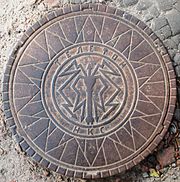People's Commissariat for Communications of the USSR
| Народный комиссариат связи СССР (НКС СССР, Наркомсвязь СССР) |
|

Official emblem of the Commissariat
on a telephone hatch in Kharkov |
|
| Agency overview | |
|---|---|
| Formed | 17 January 1932 |
| Preceding agencies |
|
| Dissolved | 15 March 1946 |
| Superseding agency |
|
| Jurisdiction | Council of People's Commissars |
| Headquarters | 7 Gorky Street, Moscow, RSFSR, Soviet Union 55°45′26″N 37°36′53″E / 55.75722°N 37.61472°E |
| Annual budget | varied |
| Agency executive |
|
| Child agency |
|
| Map | |

Union of Soviet Socialist Republics
|
|
The People's Commissariat for Communications of the USSR (Russian: Народный комиссариат связи СССР) was the central state agency of the Soviet Union for communications in the period 1932 to 1946. The Commissariat administered the postal, telegraph and telephone services.
The Commissariat was organised on 17 January 1932 by renaming from the People's Commissariat for Posts and Telegraphs of the USSR.
Over the years of the pre-World War II five-year plans (1929–1940), there was a rapid development of the Soviet communication system and industry. High-frequency equipment was introduced for long-distance communication. Use of such equipment allowed to transmit three, four, or 12 telephone calls over a pair of wires or 16 telegrams over a single telephone channel. In 1939, construction of a high-frequency three-channel line between Moscow and Khabarovsk (8,600 km) provided dependable communication between the USSR central regions and the Far East. By late 1940, the Moscow Central Telegraph Office had 22 facsimile lines. In 1941, a 12-channel line between Moscow and Leningrad was put into operation that meant the concurrent transmission of 12 telephone calls over a single pair of wires.
In the 1930s, the rural (intraraion) telephone communication was first set up. In 1940, it reached 70% of the areas under rural soviets, 76.3% of the sovkhozes, and 9.2% of the kolkhozes.
The radio broadcasting network experienced significant expansion. In the early 1930s, the Comintern Radio Station, with a power of 500 kW, was constructed along with a number of other stations with a power of 100 kW each. The receiving network was augmented, while a system for wired broadcasting via rebroadcasting centres was arranged. Regular television programming was initiated in 1939.
...
Wikipedia
